Flexural Behavior of Stainless Steel V-Stiffened Lipped Channel Beams
Abstract
1. Introduction
2. Establishment of the Experimental Study
2.1. Design of the Specimens
2.2. Material Properties
2.3. Initial Imperfections
2.4. Loading Device
2.5. Arrangement of Measuring Points
2.6. Test Procedure
3. Test Results and Analysis
3.1. Failure Mode
3.2. Flexural Capacity
3.3. Load-Span Displacement Curve
3.4. Load-Span Longitudinal Strain Curve
4. Numerical Analysis
4.1. Finite Element Model
4.2. Material Properties and Initial Geometric Imperfections
4.3. Verification of the Finite Element Model
5. Verification Based on Direct Strength Method
6. Conclusions
- In this study, the cross-sectional V-stiffeners improve distortional buckling while also increasing steel utilization. The flexural bearing capacity of the specimen will increase with an increase in the web heights of each specimen under the same stiffening form when the other sectional parameters are fixed. The application of the direct strength method (DSM) requires the identification of the buckling failure modes. Specifically, the V-stiffeners’ web compression zone at 1/3 height near the compressed flange and the V-stiffeners at the middle of the compressed flange can be used more effectively to increase the bending capacity of the specimen.
- The finite element simulation and experimental results show good agreement, which can provide a strong backing for the analysis of a number of finite element parameters for such V-stiffened lipped channel stainless steel bending members.
- In this study, it was found that the local–distortional interaction buckling failure mode predominated in the V-stiffened lipped channel sections. For the vast majority of the V-stiffened lipped channel sections that are currently available, these results might not be sufficient to offer a conclusive guide for using the DSM. The findings of this study, however, can be used as a starting point for recommendations regarding the application of the DSM for the design of such cross-sections.
Author Contributions
Funding
Data Availability Statement
Conflicts of Interest
References
- Liu, M.; Wu, Y.; Fan, S.; Wu, Q.; Liang, D. Local-distortional interaction buckling of stainless steel lipped C-section beams. J. Constr. Steel Res. 2023, 201, 107731. [Google Scholar] [CrossRef]
- Kalyanaraman, V. Local buckling of cold-formed steel members. ASCE J. Struct. Div. 1979, 105, 813–828. [Google Scholar] [CrossRef]
- Papazian, R.P.; Schuster, R.M.; Sommerstein, M. Multiple stiffened deck profiles. In Proceedings of the Twelfth International Specialty Conference on Cold-Formed Steel Structures: Recent Research and Developments in Cold-Formed Steel Design and Construction, St. Louis, MO, USA, 18–19 October 1994. [Google Scholar]
- Schafer, B.W.; Peköz, T. The behavior and design of longitudinally stiffened thin-walled compression elements. Thin-Walled Struct. 1997, 27, 65–78. [Google Scholar] [CrossRef]
- Young, B.; Chen, J. Design of cold-formed steel built-up closed sections with intermediate stiffeners. J. Struct. Eng.-Asce 2008, 134, 727–737. [Google Scholar] [CrossRef]
- Zhang, J.; Young, B. Compression tests of cold-formed steel I-shaped open sections with edge and web stiffeners. Thin-Walled Struct. 2012, 52, 1–11. [Google Scholar] [CrossRef]
- Nguyen, V.B.; Pham, C.H.; Cartwright, B.; English, M.A. Design of new cold rolled purlins by experimental testing and Direct Strength Method. Thin-Walled Struct. 2017, 118, 105–112. [Google Scholar] [CrossRef]
- Kwon, Y.B.; Kim, B.S.; Hancock, G.J. Compression tests of high strength cold-formed steel channels with buckling interaction. J. Constr. Steel Res. 2009, 65, 278–289. [Google Scholar] [CrossRef]
- Yang, D.; Hancock, G.J. Compression Tests of High Strength Steel Channel Columns with Interaction between Local and Distortional Buckling. J. Struct. Eng. 2004, 130, 1954–1963. [Google Scholar] [CrossRef]
- Wu, Y.; Fan, S.; Du, L.; Wu, Q. Research on distortional buckling capacity of stainless steel lipped C-section beams. Thin-Walled Struct. 2021, 169, 108453. [Google Scholar] [CrossRef]
- Standards Press of China. Tensile Testing of Metallic Materials-Part 1: Test Methods at Room Temperature; Standards Press of China: Beijing, China, 2010. [Google Scholar]
- Standards Press of China. Steel and Steel Products-Location and Preparation of Samples and Test Pieces for Mechanical Testing; Standards Press of China: BeiJing, China, 2018. [Google Scholar]
- Fan, S.; Chen, M.; Li, S.; Ding, Z.; Shu, G.; Zheng, B. Stainless steel lipped C-section beams: Numerical modelling and development of design rules. J. Constr. Steel Res. 2019, 152, 29–41. [Google Scholar] [CrossRef]
- Wang, H.; Zhang, Y. Experimental and numerical investigation on cold-formed steel C-section flexural members. J. Constr. Steel Res. 2009, 65, 1225–1235. [Google Scholar] [CrossRef]
- Wang, C.; Zhang, Z.; Zhao, D.; Liu, Q. Compression tests and numerical analysis of web-stiffened channels with complex edge stiffeners. J. Constr. Steel Res. 2016, 116, 29–39. [Google Scholar] [CrossRef]
- Gardner, L. A New Approach to Structural Stainless Steel Design. Ph.D. Thesis, Imperial College London, London, UK, 2002. [Google Scholar]
- Schafer, B.W.; Peköz, T. Direct strength prediction of cold-formed steel members using numerical elastic buckling solutions. In Proceedings of the Fourteenth International Specialty Conference on Cold-Formed Steel Structures: Recent Research and Developments in Cold-Formed Steel Design and Construction, St. Louis, MO, USA, 15–16 October 1998. [Google Scholar]
- Schafer, B.W. Local, Distortional, and Euler Buckling of Thin-Walled Columns. J. Struct. Eng. 2002, 128, 289–299. [Google Scholar] [CrossRef]
- AISI S100-16; North American Specification for the Design of Cold-Formed Steel Structural Members. American Iron and Steel Institute: Washington, DC, USA, 2016.
- AS/NZS 4600:2018; Australian/New Zealand Standard Cold-Formed Steel Structures. SAI Global Limited: Sydney, Australia; Standards New Zealand: Wellington, Australia, 2018.
- Martins, A.D.; Camotim, D.; Dinis, P.B. Local-distortional interaction in cold-formed steel beams: Behaviour, strength and DSM design. Thin-Walled Struct. 2017, 119, 879–901. [Google Scholar] [CrossRef]
- CUFSM, Version 5.04. 2020. Available online: http://www.ce.jhu.edu/bschafer/cufsm/ (accessed on 6 April 2020).
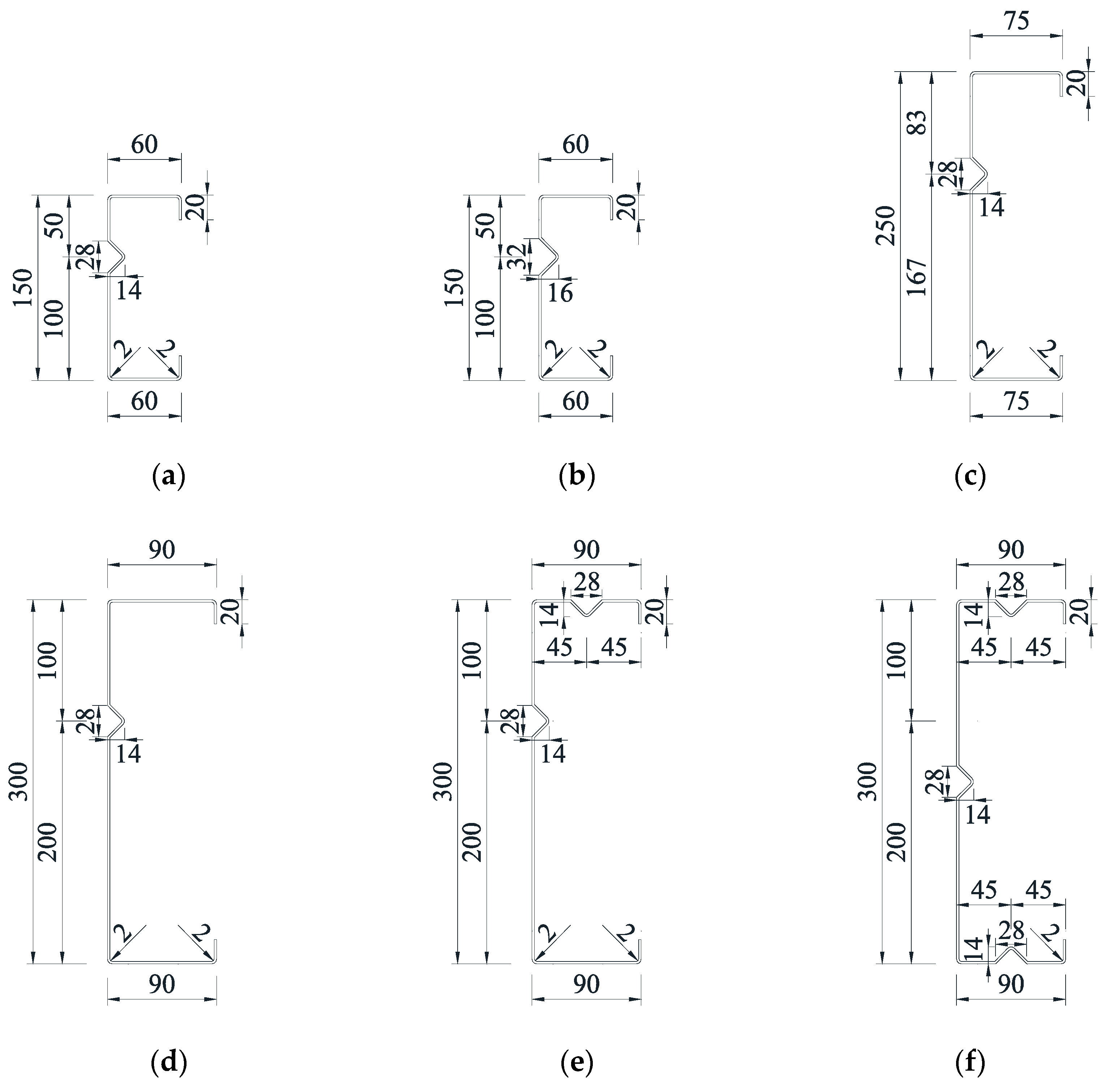
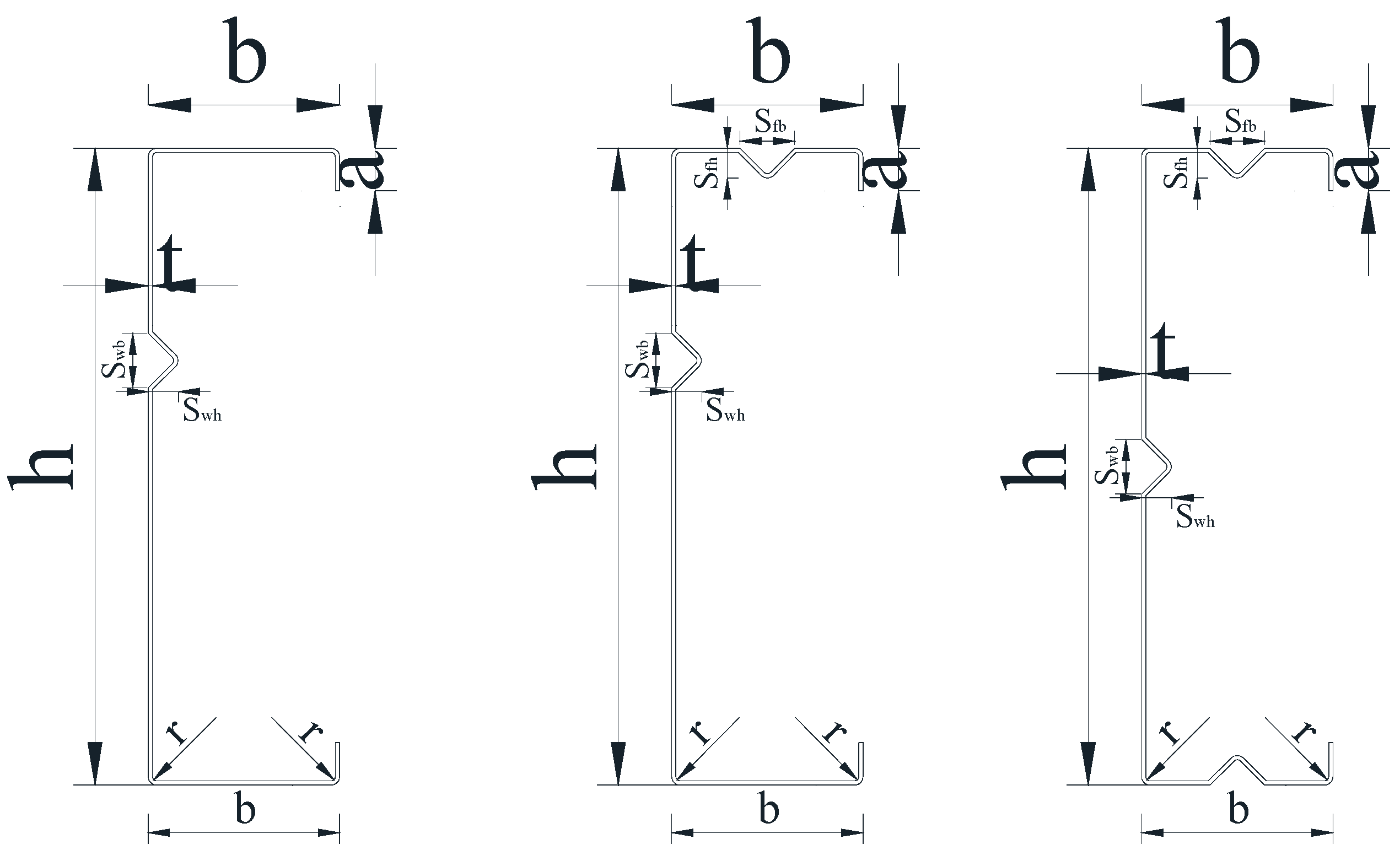
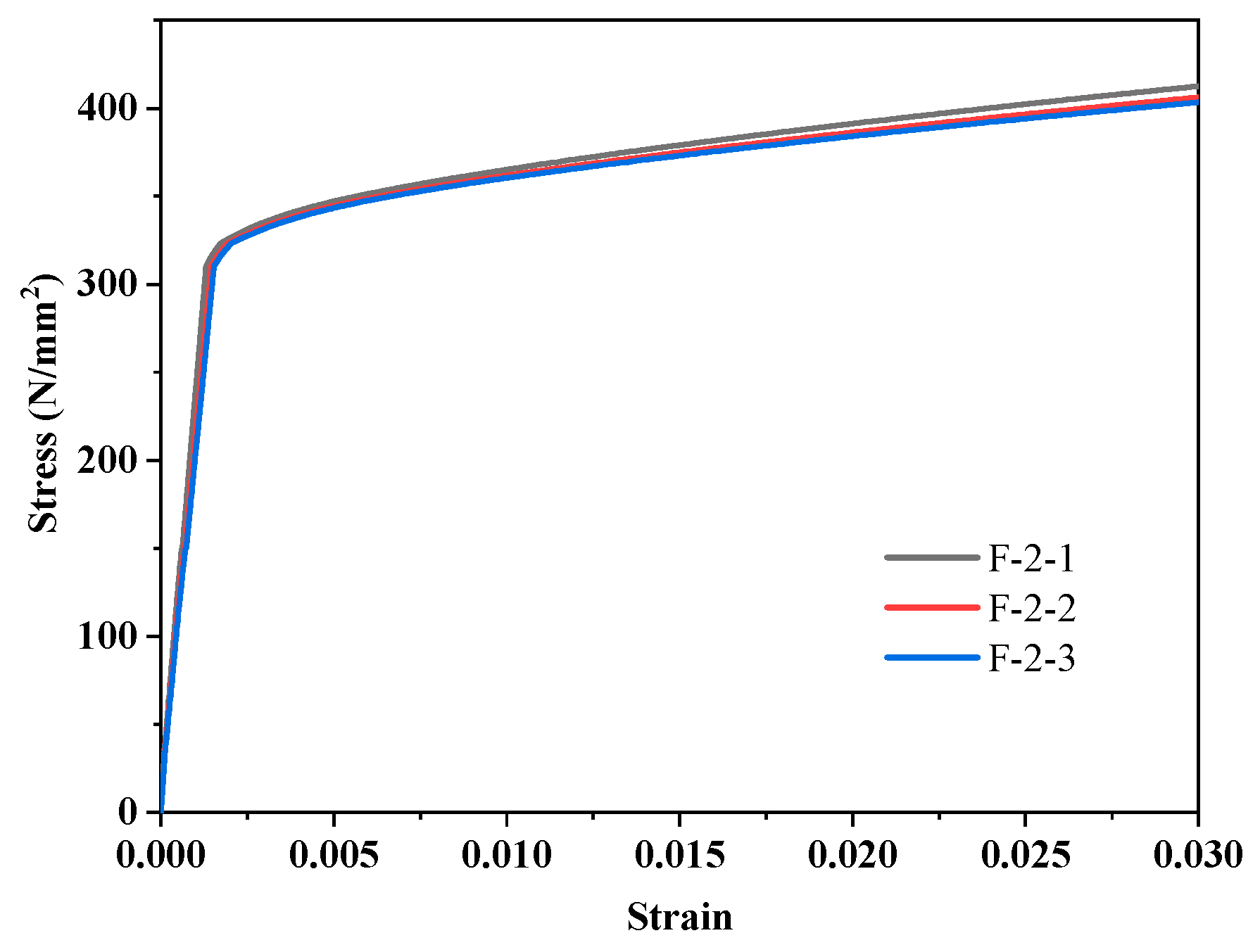
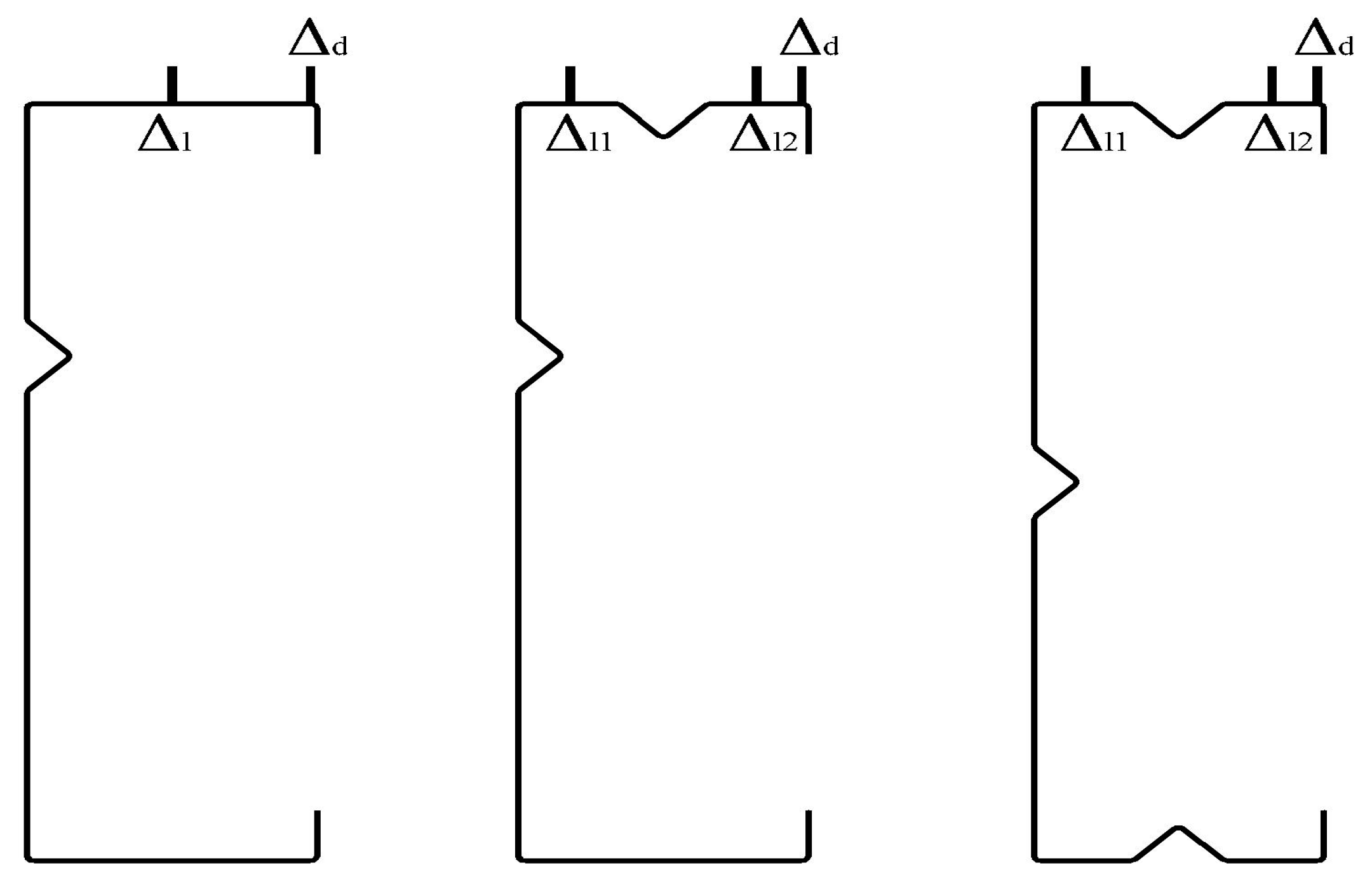
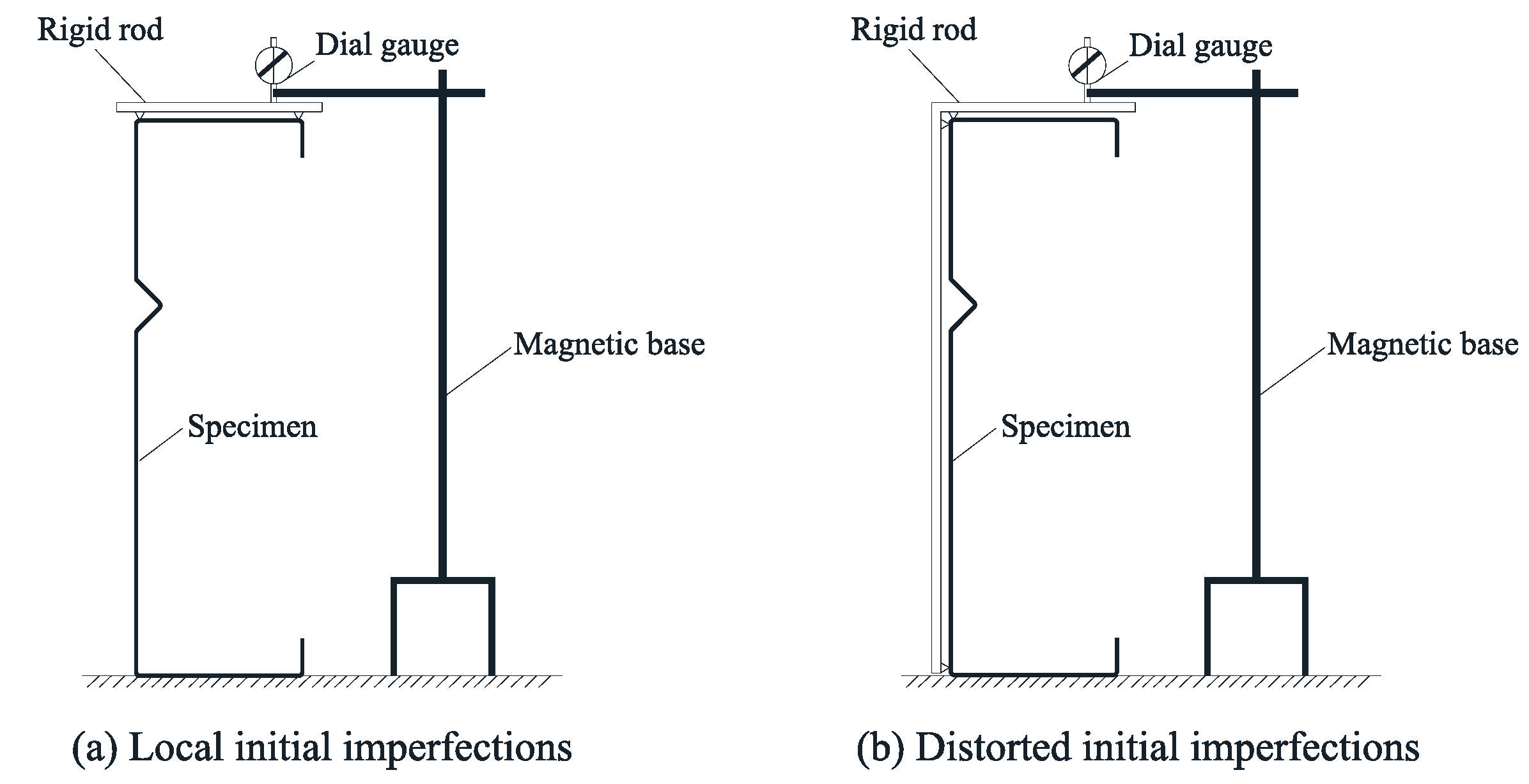
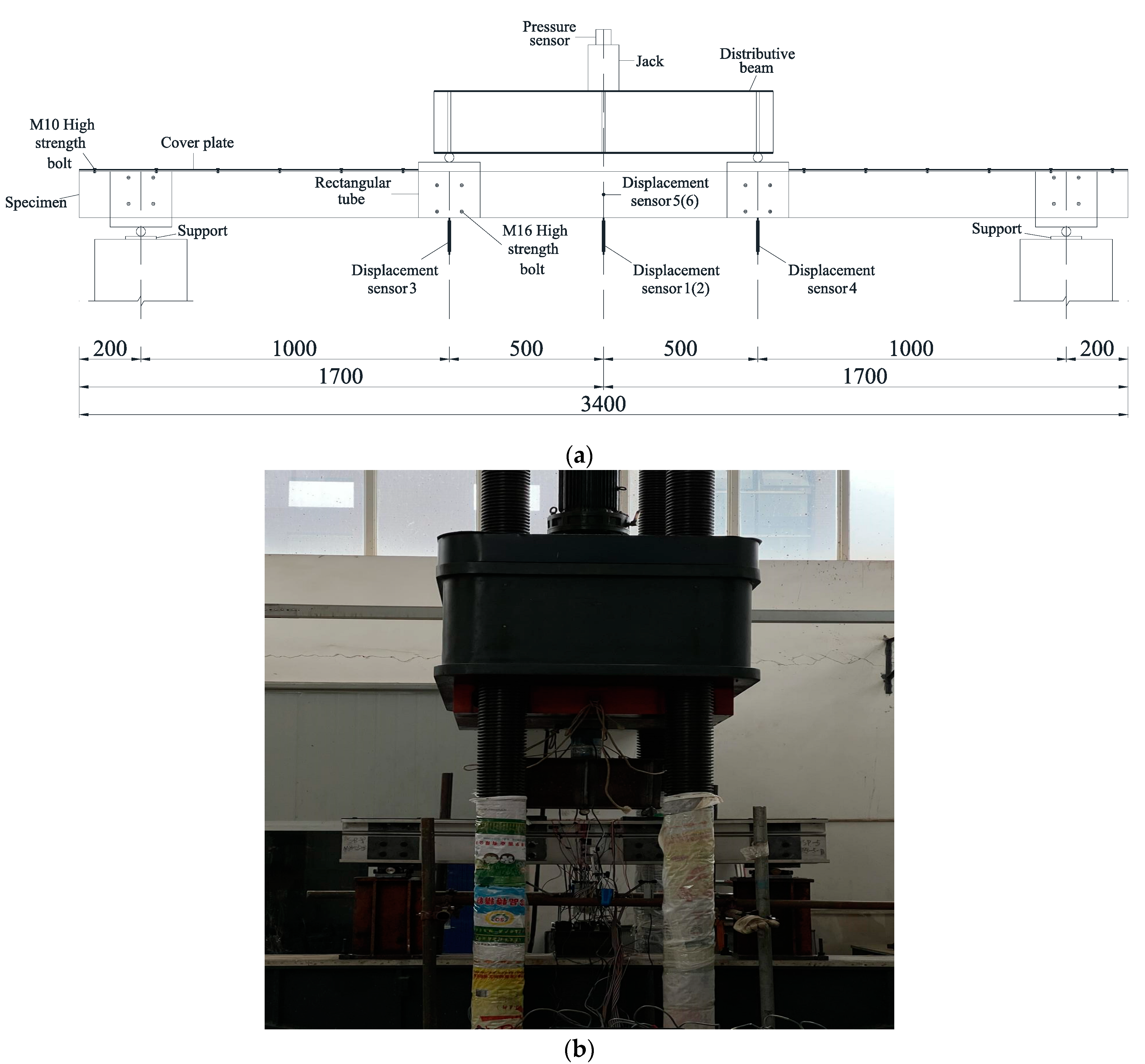
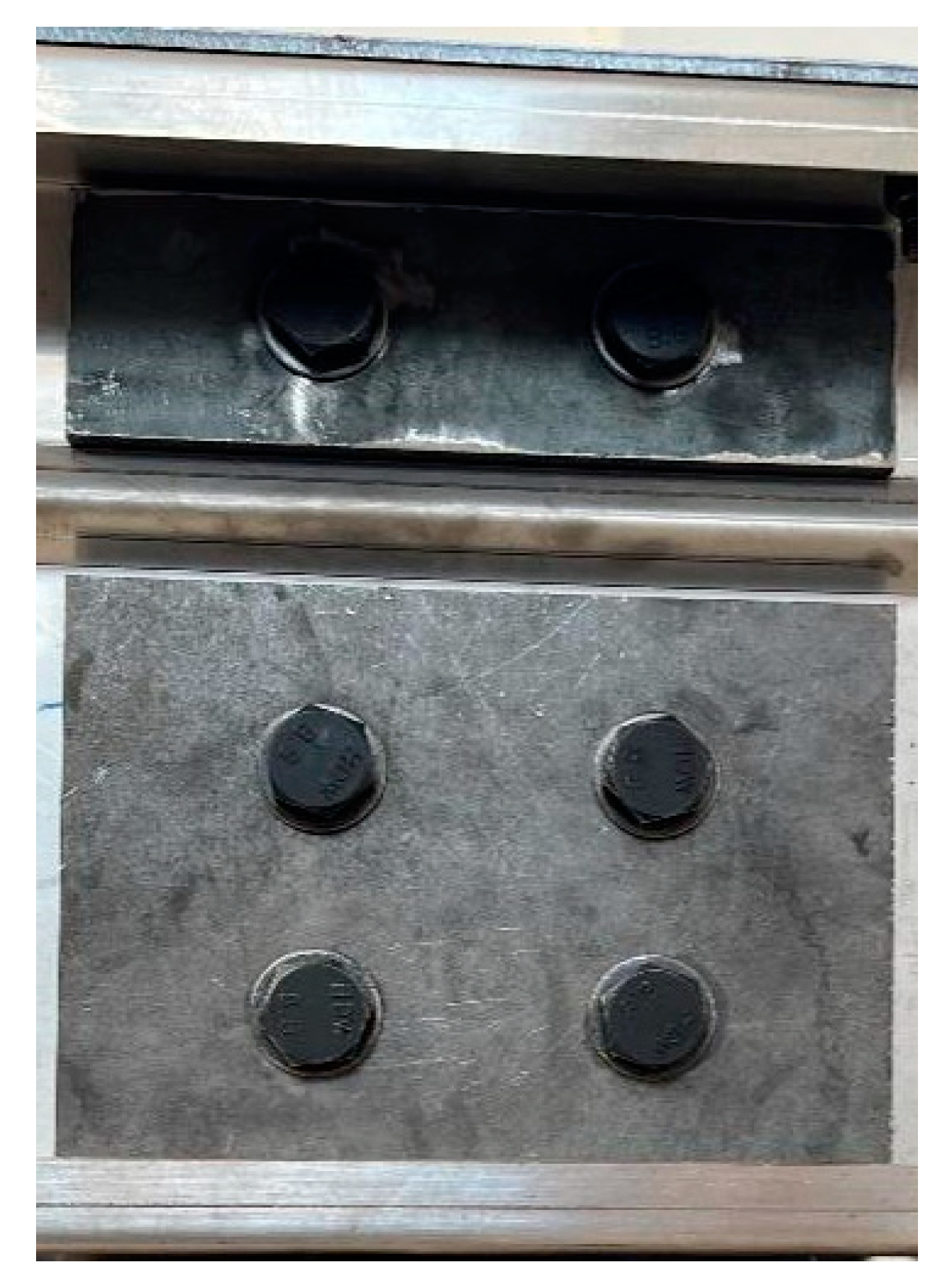
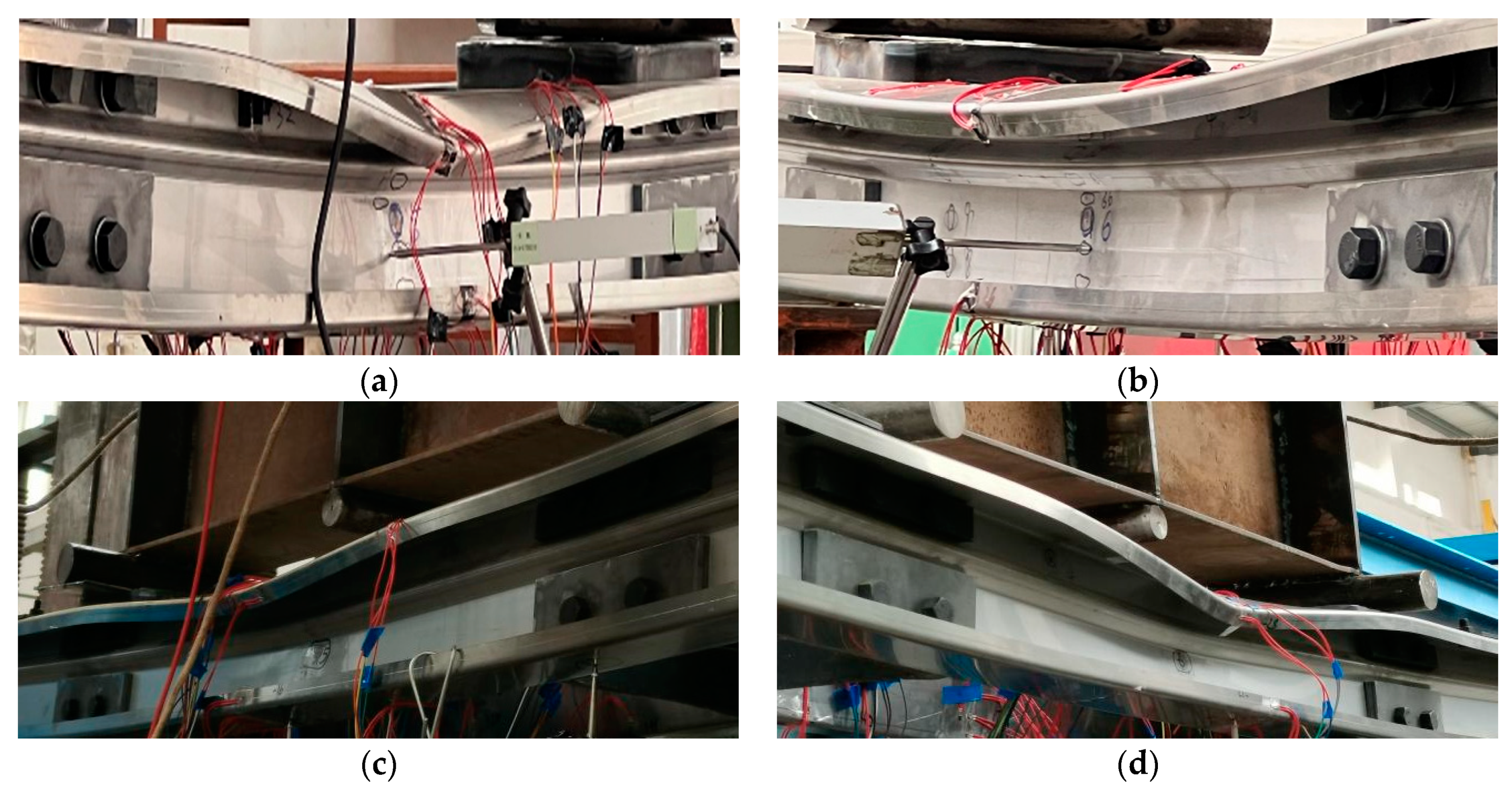
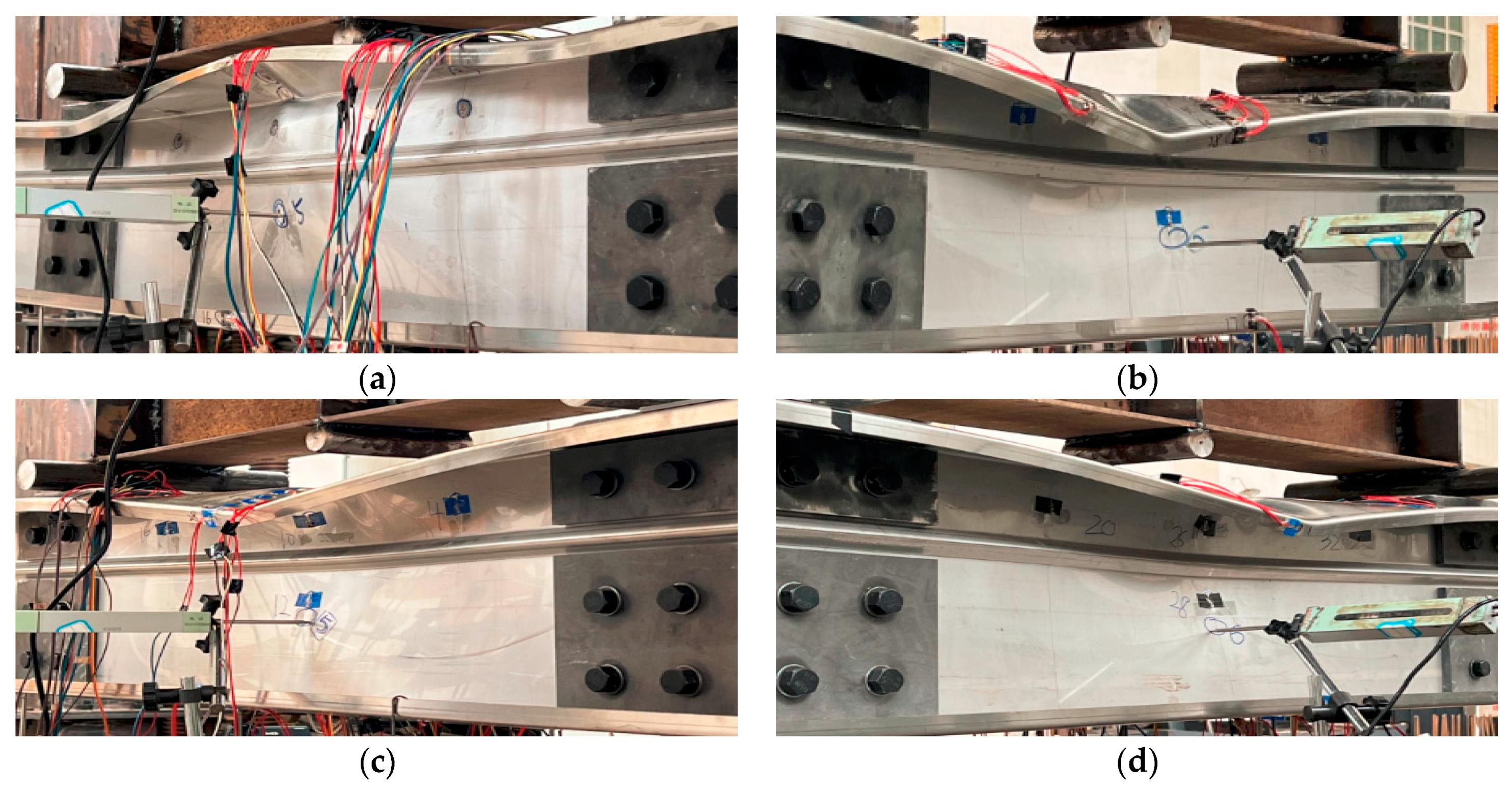


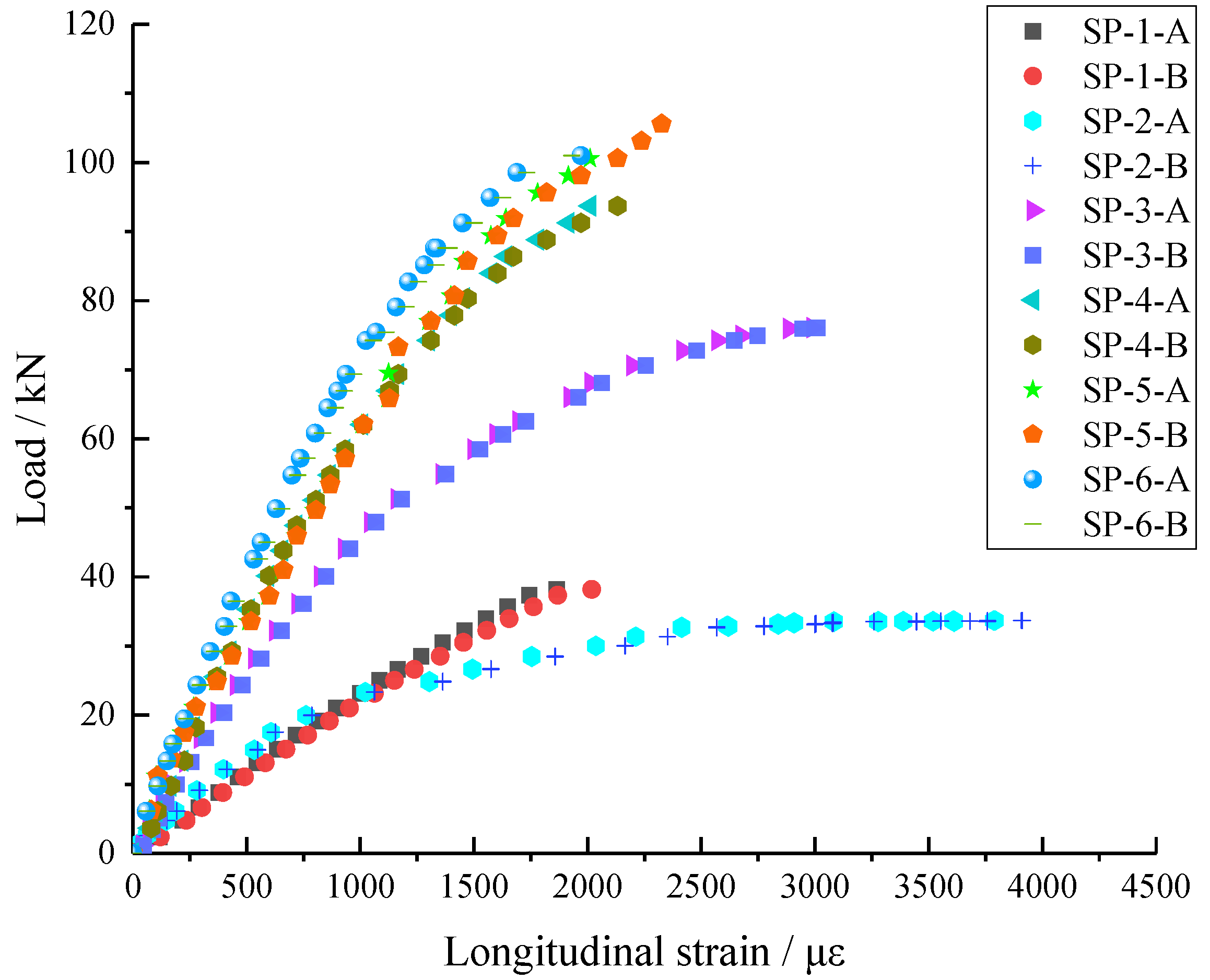
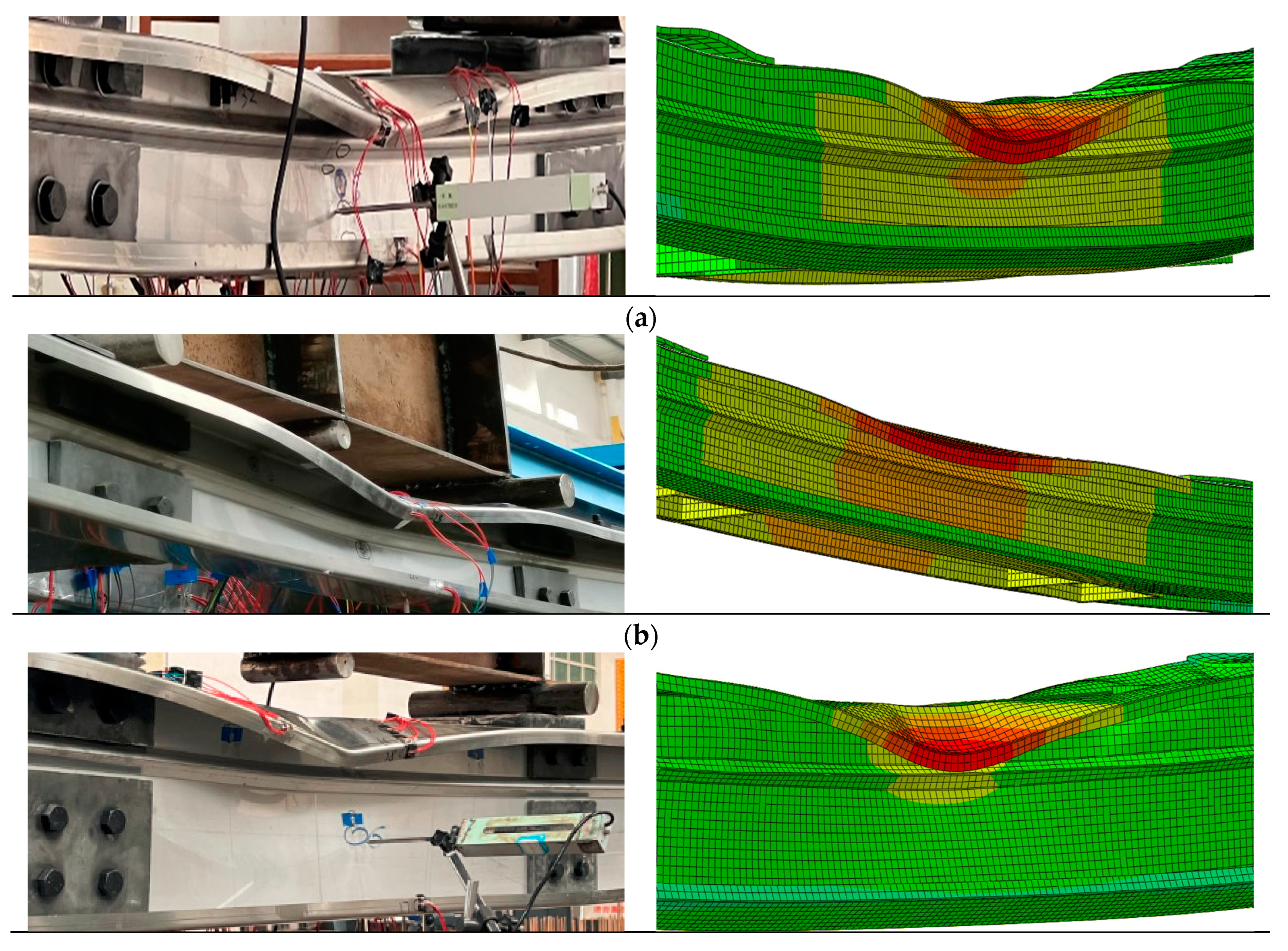
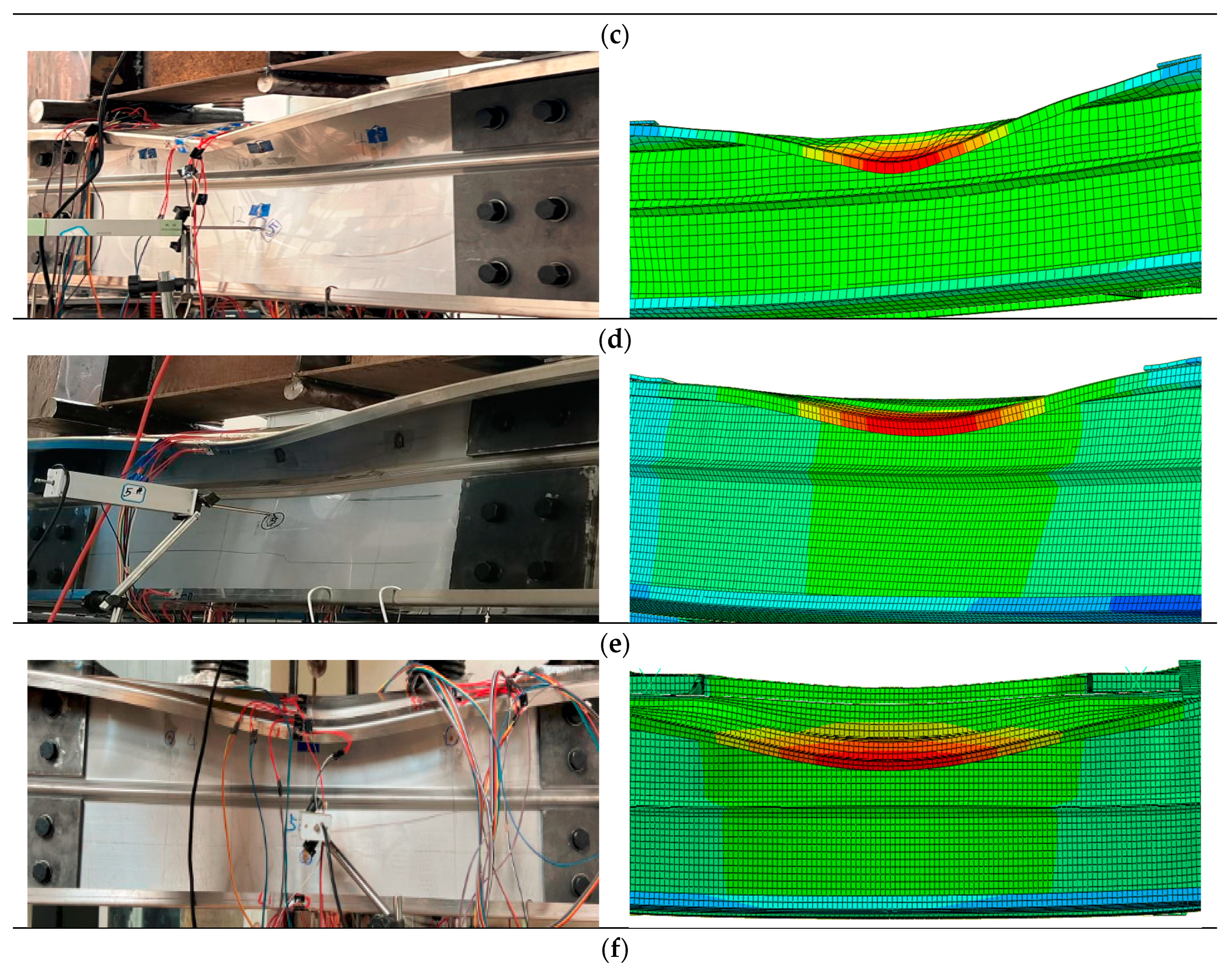

| Group | Specimen | Cross-Section/mm | h /mm | b /mm | a /mm | Swb /mm | Swh /mm | Sfb /mm | Sfh /mm |
|---|---|---|---|---|---|---|---|---|---|
| SP-1 | SP-1-A | C150 × 60 × 20 × 2.0 | 153.0 | 61.9 | 20.0 | 28.5 | 14.2 | — | — |
| SP-1-B | C150 × 60 × 20 × 2.0 | 153.9 | 61.2 | 21.2 | 28.9 | 14.8 | — | — | |
| SP-2 | SP-2-A | C150 × 60 × 20 × 2.0 | 152.0 | 61.0 | 21.8 | 32.8 | 15.9 | — | — |
| SP-2-B | C150 × 60 × 20 × 2.0 | 153.0 | 60.8 | 21.8 | 32.9 | 16.0 | — | — | |
| SP-3 | SP-3-A | C250 × 75 × 20 × 2.0 | 251.0 | 76.1 | 20.6 | 29.0 | 13.5 | — | — |
| SP-3-B | C250 × 75 × 20 × 2.0 | 252.8 | 76.7 | 20.3 | 28.5 | 13.5 | — | — | |
| SP-4 | SP-4-A | C300 × 90 × 20 × 2.0 | 303.2 | 91.4 | 20.5 | 29.2 | 15.9 | — | — |
| SP-4-B | C300 × 90 × 20 × 2.0 | 301.9 | 91.9 | 20.4 | 28.7 | 14.4 | — | — | |
| SP-5 | SP-5-A | C300 × 90 × 20 × 2.0 | 302.5 | 91.1 | 21.0 | 28.7 | 14.5 | 28.7 | 14.5 |
| SP-5-B | C300 × 90 × 20 × 2.0 | 302.0 | 91.5 | 20.8 | 28.7 | 14.8 | 28.8 | 14.8 | |
| SP-6 | SP-6-A | C300 × 90 × 20 × 2.0 | 301.5 | 92.2 | 20.4 | 29.8 | 15.2 | 30.4 | 15.1 |
| SP-6-B | C300 × 90 × 20 × 2.0 | 302.6 | 92.8 | 21.0 | 29.7 | 14.4 | 28.7 | 14.4 |
| Samples Number | σ0.2/MPa | σu/MPa | E/MPa | δ/% |
|---|---|---|---|---|
| 3 | 314.8 | 613.3 | 1.94×105 | 46.8 |
| Group | Specimen | Cross-Section /mm | ||||||||
|---|---|---|---|---|---|---|---|---|---|---|
| SP-1 | SP-1-A | C150 × 60 × 20 × 2.0 | 0.23 | — | — | 1.57 | 0.113 | — | — | 0.770 |
| SP-1-B | C150 × 60 × 20 × 2.0 | 0.21 | — | — | 1.66 | 0.103 | — | — | 0.814 | |
| SP-2 | SP-2-A | C150 × 60 × 20 × 2.0 | 0.27 | — | — | 1.85 | 0.132 | — | — | 0.907 |
| SP-2-B | C150 × 60 × 20 × 2.0 | 0.22 | — | — | 1.78 | 0.108 | — | — | 0.873 | |
| SP-3 | SP-3-A | C250 × 75 × 20 × 2.0 | 0.18 | — | — | 1.95 | 0.088 | — | — | 0.956 |
| SP-3-B | C250 × 75 × 20 × 2.0 | 0.15 | — | — | 1.93 | 0.074 | — | — | 0.946 | |
| SP-4 | SP-4-A | C300 × 90 × 20 × 2.0 | 0.11 | — | — | 1.55 | 0.054 | — | — | 0.760 |
| SP-4-B | C300 × 90 × 20 × 2.0 | 0.13 | — | — | 1.52 | 0.064 | — | — | 0.745 | |
| SP-5 | SP-5-A | C300 × 90 × 20 × 2.0 | — | 0.86 | 0.98 | 1.42 | — | 0.422 | 0.480 | 0.696 |
| SP-5-B | C300 × 90 × 20 × 2.0 | — | 0.79 | 0.94 | 1.33 | — | 0.387 | 0.461 | 0.652 | |
| SP-6 | SP-6-A | C300 × 90 × 20 × 2.0 | — | 0.43 | 0.52 | 1.53 | — | 0.211 | 0.255 | 0.750 |
| SP-6-B | C300 × 90 × 20 × 2.0 | — | 0.43 | 0.52 | 1.56 | — | 0.211 | 0.255 | 0.765 |
| Group | Specimen | Cross-Section/mm | Test Results | Finite Element Results | |||||
|---|---|---|---|---|---|---|---|---|---|
| Put /kN | Failure Mode | MTest /kN·m | Puf /kN | Failure Mode | MFEA /kN·m | ||||
| SP-1 | SP-1-A | C150 × 60 × 20 × 2.0 | 38.22 | L+D | 9.56 | 37.21 | L+D | 9.30 | 0.973 |
| SP-1-B | C150 × 60 × 20 × 2.0 | D | 9.56 | L+D | 9.30 | 0.973 | |||
| SP-2 | SP-2-A | C150 × 60 × 20 × 2.0 | 33.84 | D | 8.46 | 31.26 | D | 7.82 | 0.924 |
| SP-2-B | C150 × 60 × 20 × 2.0 | D | 8.46 | D | 7.82 | 0.924 | |||
| SP-3 | SP-3-A | C250 × 75 × 20 × 2.0 | 76.10 | D | 19.03 | 74.57 | L+D | 18.64 | 0.980 |
| SP-3-B | C250 × 75 × 20 × 2.0 | L + D | 19.03 | L+D | 18.64 | 0.980 | |||
| SP-4 | SP-4-A | C300 × 90 × 20 × 2.0 | 93.70 | L + D | 23.43 | 93.10 | L+D | 23.28 | 0.994 |
| SP-4-B | C300 × 90 × 20 × 2.0 | L + D | 23.43 | L+D | 23.28 | 0.994 | |||
| SP-5 | SP-5-A | C300 × 90 × 20 × 2.0 | 105.55 | D | 26.39 | 100.97 | D | 25.24 | 0.956 |
| SP-5-B | C300 × 90 × 20 × 2.0 | D | 26.39 | D | 25.24 | 0.956 | |||
| SP-6 | SP-6-A | C300 × 90 × 20 × 2.0 | 101.00 | D | 25.25 | 96.23 | D | 24.06 | 0.953 |
| SP-6-B | C300 × 90 × 20 × 2.0 | D | 25.25 | D | 24.06 | 0.953 | |||
| Mean | 0.963 | ||||||||
| SD | 0.022 | ||||||||
| CV (%) | 2.28 | ||||||||
| Group | Cross-Section/mm | λL | λD | Mcrl /kN·m | Mcrd /kN·m | Mtest /kN·m | MnDL-SS /kN·m | |
|---|---|---|---|---|---|---|---|---|
| SP-1 | C150 × 60 × 20 × 2.0 | 0.55 | 0.69 | 29.63 | 18.63 | 9.56 | 9.40 | 0.983 |
| SP-2 | C150 × 60 × 20 × 2.0 | 0.55 | 0.68 | 29.80 | 19.25 | 8.46 | 9.45 | 1.117 |
| SP-3 | C250 × 75 × 20 × 2.0 | 0.70 | 0.93 | 40.92 | 23.34 | 19.03 | 17.24 | 0.906 |
| SP-4 | C300 × 90 × 20 × 2.0 | 0.85 | 1.12 | 39.96 | 23.07 | 23.43 | 21.14 | 0.902 |
| SP-5 | C300 × 90 × 20 × 2.0 | 0.63 | 1.09 | 73.62 | 24.96 | 26.39 | 24.23 | 0.918 |
| SP-6 | C300 × 90 × 20 × 2.0 | 0.89 | 1.11 | 37.55 | 24.29 | 25.25 | 21.59 | 0.855 |
| Mean | 0.947 | |||||||
| SD | 0.085 | |||||||
| CV (%) | 8.98 |
Disclaimer/Publisher’s Note: The statements, opinions and data contained in all publications are solely those of the individual author(s) and contributor(s) and not of MDPI and/or the editor(s). MDPI and/or the editor(s) disclaim responsibility for any injury to people or property resulting from any ideas, methods, instructions or products referred to in the content. |
© 2023 by the authors. Licensee MDPI, Basel, Switzerland. This article is an open access article distributed under the terms and conditions of the Creative Commons Attribution (CC BY) license (https://creativecommons.org/licenses/by/4.0/).
Share and Cite
Huangfu, S.-E.; Tao, Z.; Zhang, J.; Abdul Ghafar, W.; Wang, Z.; Ye, C.; Hasan, M.M. Flexural Behavior of Stainless Steel V-Stiffened Lipped Channel Beams. Metals 2023, 13, 434. https://doi.org/10.3390/met13020434
Huangfu S-E, Tao Z, Zhang J, Abdul Ghafar W, Wang Z, Ye C, Hasan MM. Flexural Behavior of Stainless Steel V-Stiffened Lipped Channel Beams. Metals. 2023; 13(2):434. https://doi.org/10.3390/met13020434
Chicago/Turabian StyleHuangfu, Shuang-E, Zhong Tao, Ji Zhang, Wahab Abdul Ghafar, Zihao Wang, Caifeng Ye, and Md Mehedi Hasan. 2023. "Flexural Behavior of Stainless Steel V-Stiffened Lipped Channel Beams" Metals 13, no. 2: 434. https://doi.org/10.3390/met13020434
APA StyleHuangfu, S.-E., Tao, Z., Zhang, J., Abdul Ghafar, W., Wang, Z., Ye, C., & Hasan, M. M. (2023). Flexural Behavior of Stainless Steel V-Stiffened Lipped Channel Beams. Metals, 13(2), 434. https://doi.org/10.3390/met13020434






